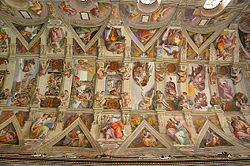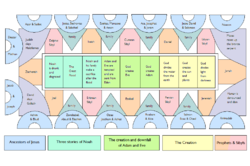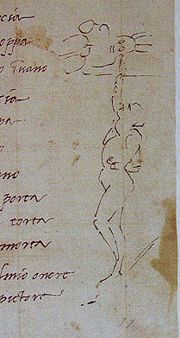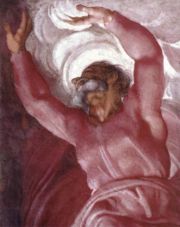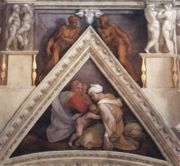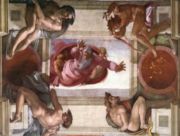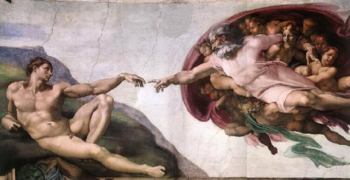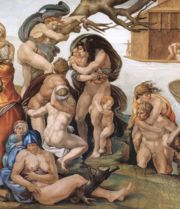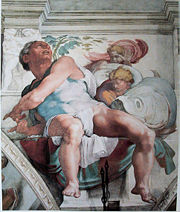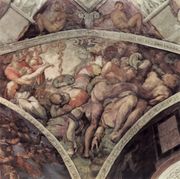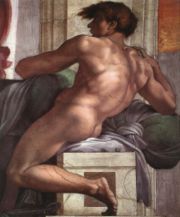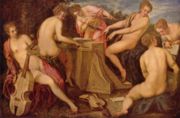Sistine Chapel ceiling
2008/9 Schools Wikipedia Selection. Related subjects: Art
The Sistine Chapel ceiling, painted by Michelangelo between 1508 and 1512, is one of the most renowned artworks of the High Renaissance. The ceiling is that of the large Sistine Chapel built within the Vatican by Pope Sixtus IV, begun in 1477 and finished by 1480.
Its various painted elements comprise part of a larger scheme of decoration within the Sistine Chapel which includes the large fresco of the Last Judgement on the sanctuary wall, also by Michelangelo, wall paintings by several other artists and a set of large tapestries by Raphael, the whole illustrating much of the doctrine of the Catholic Church.
Central to the ceiling decoration are nine scenes from the Book of Genesis of which the Creation of Adam is the best known, having an iconic standing equalled only by Leonardo da Vinci's Mona Lisa, the hands of God and Adam being reproduced in countless imitations.
History
Michelangelo was commissioned in 1505 by Pope Julius II to paint the ceiling of the Sistine Chapel. Around the central area of the walls of the chapel there already existed a complex scheme of paintings illustrating the Life of Christ and the Life of Moses.

It had been carried out by some of the most renowned Renaissance painters including Perugino, Botticelli and Ghirlandaio. Michelangelo, who was not primarily a painter but a sculptor, was reluctant to take on the work. Also, he was occupied with a very large sculptural commission for the Pope's own tomb.
The Pope was adamant, leaving Michelangelo no choice but to accept. But a war with the French broke out, diverting the attention of the Pope who was a powerful military leader, and Michelangelo fled from Rome to continue sculpting. The tomb sculptures, however, were never to be finished because in 1508 the Pope returned to Rome victorious and summoned Michelangelo to begin work on the ceiling.
The proposed scheme was for twelve large figures of the Apostles. But Michelangelo changed the scheme for a much more complex design which eventually comprised some three hundred figures and took four years, being completed in 1512.
Contrary to popular belief, he painted in a standing position, not lying on his back. According to Vasari, "The work was carried out in extremely uncomfortable conditions, from his having to work with his head tilted upwards". Michelangelo described his physical discomfort in a humorous sonnet accompanied by a little sketch.
| “ | Here like a cat in a Lombardy sewer! Swelter and toil! With my neck puffed out like a pigeon, belly hanging like an empty sack, beard pointing at the ceiling, and my brain fallen backwards in my head! Breastbone bulging like a harpy’s and my face, from drips and droplets, patterned like a marble pavement. Ribs are poking in my guts; the only way to counterweight my shoulders is to stick my butt out. Don’t know where my feet are- they’re just dancing by themselves! In front I’ve sagged and stretched; behind, my back is tauter than an archer’s bow! |
” |
Method
In order to reach the chapel's ceiling, Michelangelo designed his own scaffold, a flat wooden platform on brackets built out from holes in the wall near the top of the windows, rather than being built up from the floor which would have involved a massive structure. The scaffolding did not occupy the entire area of the ceiling. The painting was done in two stages.
The reports of Michelangelo's pupil and biographer Condivi, indicate that the brackets and frame which supported the steps and flooring were all put in place at the beginning and some sort of light-weight screen, possibly of cloth, was suspended beneath them to catch plaster drips, dust and splashes of paint, but only half the building was scaffolded at a time.
The painting technique employed was fresco, in which the paint is applied to damp plaster. Michelangelo was experienced with this method of painting, having been trained in the workshop of Ghirlandaio, one of the most competent and prolific of Florentine fresco painters, who completed several important fresco cycles in churches in Florence and whose work was represented on the walls of the Sistine Chapel.
At the outset, the plaster began to grow mold because it was too wet. Michelangelo had to remove it and start again. He then tried a new formula created by one of his assistants, Jacopo l'Indaco. This resisted mold, and entering the Italian building tradition as intonaco is still in use today.
It was customary for fresco painters to use a full-sized detailed drawing, a cartoon, to transfer a design onto a plaster surface -- many frescoes show little holes made with a stiletto, outlining the figures. Here Michelangelo broke with convention; once confident in the application of fresco, he drew directly onto the ceiling. His energetic sweeping outlines can be seen scraped into some of the surfaces, while on others a grid is evident, indicating that he enlarged directly onto the ceiling from a small drawing.
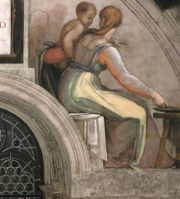
Because he was painting fresco, the plaster was laid in a new section every day, called a giornata. At the beginning of each session, the edges would be scraped away and a new area laid down. This is more apparent in the Last Judgement than on the ceiling. The reason that Michelangelo employed the fresco technique is that if the artist worked onto completely dry plaster, then every brushstroke sank in immediately and the pigment could not be manipulated without removal of the plaster. The disadvantage of fresco painting is that the plaster becomes very hot while it is setting and gives off fumes.
Michelangelo painted onto the damp plaster using a wash technique to apply broad areas of colour, then as the surface became drier, he revisited these areas with a more linear approach, adding shade and detail with a variety of brushes. For some textured surfaces, such as facial hair and woodgrain, he used a broad brush with bristles as sparse as a comb. Altogether, Michelangelo's techniques show the skill that one would expect of Ghirlandaio's greatest pupil. He employed all the finest workshop methods and best innovations, combining them with a diversity of brushwork and breadth of skill of which the meticulous and accurate Ghirlandaio was not capable.
The work commenced at the end of the building furthest from the altar and coinciding with the latest of the narrative scenes, rather than the earliest. The first three scenes, from the story of Noah, contain a much larger number of small figures than the later panels. This is partly because of the subject matter, which deals with the fate of Humanity, but also because all the figures at that end of the ceiling, including the prophets and ignudi, are smaller than in the central section. The scale further increased in the third section. As the scale got larger, so did Michelangelo's style become broader, the final narrative scene of God in the act of Creation was painted in a single day.
The bright colours and broad, cleanly-defined outlines make each subject easily visible from the floor. Despite the height of the ceiling the proportions of the Creation of Adam are such that when standing beneath it, "it appears as if the viewer could simply raise a finger and meet those of God and Adam". The colours, which now appear so fresh and spring-like with pale pink, apple green, vivid yellow and sky blue against a background of warm pearly grey, were so discoloured by candlesmoke as to make the pictures seem almost monochrome. The long restoration (1981 through 1994) has removed the filter of grime to reveal the colours again.
Vasari tells us that the ceiling is "unfinished", that its unveiling occurred before it could be reworked with gold leaf and vivid blue lapis lazuli as was customary with frescoes and in order to better link the ceiling with the walls below it which were highlighted with a great deal of gold. But this never took place, in part because Michelangelo was reluctant to set up the scaffolding again, and probably also because the gold and particularly the intense blue would have distracted from his painterly conception.
Some areas were, in fact, decorated with gold:- the shields between the ignudi and the columns between the prophets and sybils. It seems very likely that the gilding of the shields was part of Michelangelo's original scheme since they are painted to resemble a certain type of processional shield a number of which still exist.
Section reference.
Content
The subject matter of the ceiling is the doctrine of Humankind's need for Salvation as offered by God through Jesus.
In other words, the ceiling illustrates that God made the World as a perfect creation and put Humankind into it, Humankind fell into disgrace and was punished by death, and by separation from God. God sent Prophets and Sybils to tell Humankind that the Saviour or Christ, Jesus, would bring them redemption. God prepared a lineage of people, all the way from Adam, through various characters written of in the Old Testament, such as King David, to the Virgin Mary through whom the Saviour of Humankind, Jesus, would come. The various components of the ceiling are linked to this doctrine.
But there was another factor. During the 15th century in Italy, and in Florence in particular, there was a strong interest in Classical literature and the philosophy of Humanism. Michelangelo, as a young man, had spent time at the Humanist academy established by the Medici family in Florence. He was familiar with early Humanist-inspired sculptural works such as Donatello's bronze David, and had himself responded by carving the enormous nude marble David which was placed in the piazza near the Palazzo Vecchio, the home of Florence's council. The Humanist vision of Humankind was one in which people responded to other people, to social responsibility and to God in a direct way, not through intermediaries, such as the Church. This conflicted with the Church's emphasis. While the Church emphasised Humankind as essentially sinful and flawed, Humanism emphasised Humankind as potentially noble and beautiful. These two views were not necessarily irreconcilable to the Church, but only through a recognition that the unique way to achieve this "elevation of spirit, mind and body" was through the Church as the agent of God. To be outside the Church was to be beyond Salvation.
In the ceiling of the Sistine Chapel, Michelangelo has presented both Catholic and Humanist elements in a way that does not appear visually conflicting, but the inclusion of "non-Christian" figures can appear as an ideological conflict to those more familiar with the intensely "religious" works of the Counter Reformation and unfamiliar with the rationalising of Humanist and Christian thought of the Renaissance.
The main components of the design are nine scenes from the Book of Genesis, of which five smaller ones are each framed and supported by four naked youths or "ignudi". At either end, and beneath the scenes are the figures of twelve men and women who prophesied the birth of Jesus. On the cresent-shaped areas, or "lunettes", above each of the chapel's windows are the Ancestors of Christ, identified by name. In the triangular spandrels above them are a further eight groups of figures, the identity of which is not known and which is subject to speculation. The scheme is completed by four large corner pendentives each showing a dramatic Biblical story. The iconography of the ceiling has had various interpretations in the past, some elements of which have been contradicted by modern scholarship and others of which continue to defy interpretation. Of interest to some modern scholars is the question of how Michelangelo's own spiritual and psychological state is reflected in the iconography and the artistic expression of the ceiling.
Section reference
Architectural scheme
See above: Plan of real and fictive architecture
Real
The Sistine Chapel is 40.5 metres long and 14 metres wide. The ceiling rises to 20 metres above the main floor of the chapel. The vault is of quite a complex nature and it is unlikely that it was originally intended to have such complex decoration. Pier Matteo d'Amelia provided a plan for its decoration with the architectural elements picked out and the ceiling painted blue and dotted with gold stars, similar to that of the Arena Chapel decorated by Giotto at Padua.
The chapel walls have three horizontal tiers with six windows in the upper tier down each side. There were also two windows at each end, but these have been closed up above the altar when Michelangelo's Last Judgement was painted. Between the windows are large pendentives which support the vault. Between the pendentives are triangularly shaped arches or spandrels cut into the vault above each window. Above the height of the pendentives, the ceiling slopes gently without much deviation from the horizontal. This is the real architecture. Michelangelo has elaborated it with illusionary or fictive architecture.
Illusionary
The first element in the scheme of painted architecture is the defining of the real architectural elements by painted decorative courses that look like stone moldings. The decorative courses have two repeating motifs, a formula common to such decorations in Classical Roman buildings. In this case one motif is the acorn, the symbol of the Pope's family, the Rovere.. The other motif is the scallop shell, one of the symbols of the Blessed Virgin Mary to whom the chapel is dedicated.
Part of Michelangelo's painted design are broad architectural ribs of travertine which appear to cross the ceiling from one pendentive to another, further supported by similar architectural bands at either end of the chapel. The ten painted cross-ribs divide the ceiling into alternately wide and narrow pictorial spaces. Above the level of the spandrels, where the ceiling flattens, is painted a strongly-projecting cornice that runs right around the ceiling, enclosing the main pictorial areas. These fictive architectural elements form a grid in which all the figures have defined spaces.
Integrated with the painted architecture are a great number of small figures the purpose of which appears to be purely decorative. These include two seemingly-marble putti below the cornice on each rib, stone rams-heads above the spandrels, figures like animated book-ends hiding in the shadows of the ribs and little putti, both clothed and unclothed who strike a variey of poses as they support the name-plates of the prophets and sybils.
Above the cornice and to either side of the smaller scenes are an array of round shields. They are in part supported by twenty more figures, not part of the architecture, but sitting on inlaid plinths, their feet planted convincingly on the fictive cornice. They are the so-called ignudi.
Pictorial scheme
Nine scenes from the Book of Genesis
Along the central section of the ceiling, Michelangelo depicted nine scenes from the Book of Genesis, the first book of the Bible. The pictures fall into three groups of three.
The first group shows God creating the Heavens and the Earth. The second group shows God creating the first man and woman, Adam and Eve, and their disobedience of God and consequent expulsion from the Garden of Eden where they have lived and where they walked with God. The third group of three pictures shows the plight of Humanity, and in particular the family of Noah.
The pictures are not in strictly chronological order. If they are perceived as three groups, then the pictures in each of the three units inform upon each other, in the same way as was usual in Medieval paintings and stained glass.
The scenes are painted so as to be viewed looking from the altar towards the main door and are ordered accordingly, as follows:
- The Separation of Light and Darkness
- The Creation of the Sun, Moon and Earth
- The Separation of Land and Water
- The Creation of Adam
- The Creation of Eve
- The Temptation and Expulsion
- The Sacrifice of Noah
- The Great Flood
- The Drunkenness of Noah
Creation
The three Creation pictures show scenes from the first chapter of Genesis, which relates that God created the Earth and all that is in it in six days, resting on the seventh day. In the first scene, the First Day of Creation, God creates light and separates light from darkness. Chronologically, the next scene takes place in the third panel, in which, on the Second Day, God divides the waters from the heavens. In the central panel, the largest of the three, there are two representations of God. On the Third Day, God creates the Earth and makes it sprout plants. On the Fourth Day, God puts the Sun and the Moon in place to govern the night and the day, the time and the seasons of the year. On the Fifth Day, God created the birds of the air and fish and creatures of the deep, but we are not shown this. Neither do we see God's creation of the creatures of the earth on the Sixth Day.
These three scenes, completed in the third stage of painting, are the most broadly conceived, the most broadly painted and the most dynamic of all the pictures. Of the first scene Vasari says "...Michelangelo depicted God dividing Light from Darkness, showing him in all his majesty as he rests self-sustained with arms outstretched, in a revelation of love and creative power."
Adam and Eve
For the central section of the ceiling, Michelangelo has taken four episodes from the story of Adam and Eve as told in the first, second and third chapters of Genesis. In this sequence of three, two of the panels are large and one small.
In the first of the pictures, and one of the most widely recognised images in the history of painting, Michelangelo shows God reaching out to touch Adam, who, in the words of Vasari, is "a figure whose beauty, pose and contours are such that it seems to have been fashioned that very moment by the first and supreme creator rather than by the drawing and brush of a mortal man."
The central scene, of God creating Eve from the side of the sleeping Adam has been taken in its composition directly from another Creation sequence familiar to Michelangelo from his youth, the relief panels by Jacopo della Quercia that surround the door of the Basilica of San Petronio, Bologna.
In the final panel of this sequence Michelangelo shows two contrasting scenes, that of Adam and Eve taking fruit from the forbidden tree, Eve trustingly taking it from the hand of the Serpent and Adam eagerly picking it for himself; and their banishment from the Garden of Eden, where they have lived in the company of God, to the world outside where they have to fend for themselves and experience death.
Story of Noah
As with the first sequence of pictures, the three panels concerning Noah, taken from the sixth to ninth chapters of Genesis are thematic rather than chronological. In the first scene is shown the sacrifice of a sheep. There are two significant sacrifices written of in Genesis, and Vasari, in writing about this scene mistakes it for the sacrifices by Cain and Abel, in which Abel's sacrifice was acceptable to God and Cain's was not. What this image almost certainly depicts is the sacrifice made by the family of Noah, after their safe deliverance from the Great Flood which destroyed the rest of Humankind. However, blood sacrifice was instigated at the sacrifice of Abel. Christ was called the "Lamb of God" with reference to his sacrificial death. So this episode has far greater doctrinal significance than a family thanksgiving.
The central, larger, scene shows the Great Flood. The Ark in which Noah's family escaped floats at the rear of the picture while the rest of humanity tries frantically to scramble to some point of safety. This picture, which has a large number of figures, conforms the most closely to the format of the paintings that had been done around the walls.
The final scene of Humankind's degredation is the story of Noah's drunkenness. After the Flood, Noah tills the soil and grows vines. He is shown doing so, in the background of the picture. He becomes drunk and inadvertently exposes himself. His youngest son, Ham, brings his two brothers Shem and Japheth to see the sight but they discreetly cover their father with a cloak. Ham is later cursed by Noah and told that he will serve his brothers forever.
Taken together, these three pictures of death, destruction and degredation serve to show that Humankind, represented by Noah's family, had moved a long way from God's perfect creation.
Shields
Adjacent to the smaller Biblical scenes and supported by the ignudi are ten circular pageant shields, painted to resemble bronze or leather and with their details picked out in gold leaf. Each is decorated with a picture drawn from the Old Testament or the Book of Maccabees. The subject in almost every case is one of the more gruesome or shameful of Biblical episodes, the only exception being that of Elijah being swept up to Heaven in a Chariot of Fire, leaving Elisha in a state of despair. In four of the five most highly finished medallions the space is crowded with figures in violent action, similar to Michelangelo's cartoon for the Battle of Cascina.
The technique that Michelangelo has employed is unusual in fresco, and may be original in its employment on this scale, but is not unique. He has utilised the same technique that was employed for decorating shields used in pageants and is similar to that used when drawing in metal point and white chalk on a coloured ground. The ground colour (in this case red ochre streaked with black) makes the background and all the mid tones in the composition. The shadowed edges are then painted or rather, drawn with a brush and the shadows drawn in a highly linear manner that defines the contours of the forms. On coloured paper, the highlights and brightly lit contours would usually be drawn with white chalk or finely painted in white paint. But in this case, gold leaf entirely replaces the white and has been applied exactly as if it had been drawn on, using the same method of defining contour as the black lines.
This application of gold serves to link the ceiling frescoes to some extent with those around the walls. In the latter, gold leaf has been applied lavishly to many details and in some of the frescoes, notable those by Perugino, has been most expertly used not just to detail the robes but to highlight the folds by subtle graduation in the density of golden flecks. It is this technique that Michelangelo has picked up on and carried a step further, inspired also perhaps by the medallions that appear on a Roman triumphal arch in Botticelli's episode from the Life of Moses, showing the punishment of the Sons of Corah.
The medalions represent:-
- Abraham about to sacrifice his son Isaac
- The Destruction of the Statue of Baal
- The worshippers of Baal being brutally slaughtered.
- Uriah being beaten to death.
- Nathan the priest condemning King David for murder and corruption.
- King David's traitorous son Absalom caught by his hair in a tree while trying to escape and beheaded by David's troops.
- Abner sneaking up on Joab to murder him
- Joram being hurled from a chariot onto his head.
- Elijah being carried up to Heaven
- On one medalion the subject is either obliterated or incomplete.
Section references
Twelve prophetic figures
On the five pendentives along each side and the two at either, Michelangelo painted the largest figures on the ceiling: twelve people who prophesied or represented some aspect of the Coming of Christ. Of those twelve, seven were Prophets of Israel and were male. The remaining five were prophets of the Classical World, called Sibyls and were female. The prophet Jonah is placed above the altar and Zechariah at the further end. The other male and female figures alternate down each side, each being identified by an inscription on a painted marble panel supported by a putto.
- Jonah (IONAS) - above the altar
- Jeremiah (HIEREMIAS)
- Persian Sibyl (PERSICHA)
- Ezekiel (EZECHIEL)
- Erythraean Sibyl. (ERITHRAEA)
- Joel (IOEL)
- Zechariah (ZACHERIAS) - above the main door of the chapel
- Delphic Sibyl. (DELPHICA)
- Isaiah (ESAIAS)
- Cumaean Sibyl. (CVMAEA)
- Daniel (DANIEL)
- Libyan Sibyl (LIBICA)
Prophets
The seven prophets of Israel chosen for depiction on the ceiling include the four so-called Major Prophets, Isaiah, Jeremiah, Ezekiel and Daniel. Of the remaining twelve possibilities among the Minor Prophets, the three represented are Joel, Zechariah and Jonah.
Although the prophets Joel and Zechariah are considered "minor" because of the comparatively small number of pages that their prophecy occupies in the Bible, each one produced prophesies of profound significance. They are often quoted, Joel for his "Your sons and your daughters shall prophesy, your elderly shall dream dreams and your youth shall see visions". These words are significant for Michelangelo's decorative scheme, where women take their place among men and the youthful Daniel sits across from the brooding Jeremiah with his long white beard.
Zechariah prophesied "Behold! Your King comes to you, humble and riding on a donkey". His place in the chapel is directly above the door through which the Pope is carried in procession on Palm Sunday, the day on which Jesus fulfilled the prophecy by riding into Jerusalem on a donkey and being proclaimed King.
Jonah's main prophesy concerned the downfall of the city of Nineveh. This alone does not seem to warrant him a place above the High Altar. But there is another factor involved. It is the person of Jonah himself that is of symbolic and prophetic significance, a significance which was commonly understood and had been represented in countless works of art including manuscripts and stained glass windows. Jonah, through his reluctance to obey God, was swallowed by a "mighty fish". He spent three days in its belly and was eventually spewed up on dry land where he went about God's business. Because of this, Jonah was seen as a forerunner of Jesus, who having died by crucifixion, spent a time which spanned part of three days in a tomb, and was resurrected on the third day. So, on the ceiling of the Sistine Chapel, Jonah, with the "great fish" beside him and his eyes turned towards God the Creator, represents a "portent" of the Resurrection of Christ.
In Vasari's description of the prophets and sibyls he is particularly high in his praise of the portrayal of Isaiah: "Anyone who studies this figure, copied so faithfully from nature, the true mother of the art of painting, will find a beautifully composed work capable of teaching in full measure all the precepts to be followed by a good painter."
Section references
Sibyls
The sibyls were prophetic women who were resident at shrines or temples throughout the Classical World. The five depicted here are each said to have prophesied the birth of Christ. The Cumaean Sibyl, for example, is quoted by Virgil as declaring that "a new progeny of Heaven" would bring about a return of the " Golden Age". This was interpreted as referring to Jesus.
In Christian doctrine, Christ came not just to the Jews but also to the Gentiles. It was understood that, prior to the Birth of Christ, God prepared the world for his coming. To this purpose, God used Jews and Gentiles alike. Jesus would not have been born in Bethlehem (where it had been prophesied that his birth would take place), except for the fact that the pagan Roman Emperor Augustus decreed that there should be a census. Likewise, when Jesus was born, the announcement of his birth was made to rich and to poor, to mighty and to humble, to Jew and to Gentile. The wise men or so-called " Magi" who sought out the infant King with precious gifts were pagan foreigners.
In the Church of Rome, where there was an increasing interest in the remains of the city's pagan past, where scholars turned from reading Medieval Church Latin to Classical Latin and the philosophies of the Classical world were studied along with the writings of St Augustine, the presence, in the Sistine Chapel of five pagan prophets is not surprising.
It is not known why Michelangelo selected the five particular sibyls that were depicted, given that, as with the Minor Prophets, there were ten or twelve possibilities. It is suggested by John O'Malley that the choice was made for a wide geographic coverage, with the sibyls coming from Africa, Asia, Greece and Ionia.
Vasari says of the Erythraean sibyl "Many aspects of this figure are of exceptional loveliness: the expression of her face, her headdress and the arrangement of her draperies: and her arms, which are bared, are as beautiful as the rest."
Section reference
Pendentives
In each corner of the chapel is a triangular pendentive filling the space between the walls and the arch of the vault and forming the spandrel above the windows nearest the corners. On these curving shapes Michelangelo has painted four scenes from Biblical stories that are associated with the salvation of the Jewish people.
- The Brazen Serpent
- The Punishment of Haman
- David and Goliath
- Judith and Holofernes
The first two stories were both seen in Medieval and Renaissance theology as prefiguring the Crucifixion of Jesus. In the story of the Brazen Serpent, the people of Israel become dissatisfied and grumble at God. As punishment they receive a plague of poisonous snakes. God offers the people relief by instructing Moses to make a snake of brass, set up on a pole, the sight of which gives miraculous healing.
In the book of Esther it is related that Haman, a public servant, plots to get Esther's husband, the King of Persia, to slay all the Jewish people in his land. The King, who is going over his books during a sleepless night, realises something is amiss. Esther, discovering the plot, denounces Haman and her husband orders his execution on a scaffold he has built. The King's Eunuchs promptly carry this out.
The other stories, those of David and Judith, while showing the Salvation of Israel, were both portrayed with great frequency in the art of Florence as they demonstrated the overthrow of tyrants, a popular subject in the Republic. In this image, the shepherd boy, David, has brought down the towering Goliath with his sling, but the giant is alive and is trying to rise as David forces his head down to chop it off.
The depiction of Judith and Holofernes has an equally gruesome detail. As Judith loads the enemy's head onto a basket carried by her maid and covers it with a cloth, she is distracted by the limbs of the decapitated body threshing around.
There are obvious connections in the design of the Slaying of Holofernes and the Slaying of Haman at the opposite end of the chapel. Although in the Holofernes picture the figures are smaller and the space less filled, both have the triangular space divided into two zones by a vertical wall, allowing us to see what is happening on both sides of it. There are actually three scenes in the Haman picture because as well as seeing Haman punished, we see him at the table with Esther and the King and get a view of the King on his bed. The servants who have done the ghastly deed are on the steps, making a link between the scenes.
While the Slaying of Goliath is a relatively simple composition with the two protagonists centrally placed, the only other figures being dimly-seen observers, the Brazen Serpent picture is crowded with figures and separate incidents as the various individuals who have been attacked by snakes struggle and die or turn towards the icon that will save them. This is the most Mannerist of Michelangelo's earlier compositions at the Sistine Chapel, picking up the theme of human distress begun in the Great Flood scene and carrying it forward into the torment of lost souls in the Last Judgement which was later to be painted below.
Ancestors of Christ
Subject
Between the large pendentives that support the vault are windows, six on each side of the chapel. There were two more windows in each end of the chapel, now closed, and those above the High Altar covered by the Last Judgement. Above each window is an arched shaped, referred to as a lunette and above eight of the lunettes at the sides of the chapel are triangular spandrels filling the spaces between the side pendentives and the vault, the other eight lunettes each being below one of the corner pendentives.
Michelangelo was commissioned to paint these areas, as part of the work on the ceiling. the structures form visual bridges between the walls and the ceiling, and the figures that are painted on them are midway in size (approximately 2 metres high) between the very large prophets and the much smaller figures of Popes which had been painted to either side of each window in the 15th century. The subject of the pictures is the Genealogy of Christ.
Centrally placed above each window is a painted marble tablet with a decorative frame. On each is painted the names of the male line by which Jesus, through his Earthly father, Joseph, is descended from Abraham, according to the Gospel of Matthew.
The arrangement seems a little erratic as one plaque has four names, most have three or two, and two plaques have only one. Moreover, the progression moves from one side of the building to the other, but not consistently.
On either side of each plaque and occupying the greater part of each lunette, are figures. In each case they seem to comprise some sort of a family, but it is extremely difficult to determine who the painted characters represent, as they do not coincide closely with the listed names. There are babies in most of the pictures suggesting a parental relationship between the males and females depicted, but not in every case.
There is also an indeterminate relationship between the figures in the spandrels, which are predominantly women with babies, and the lunettes beneath them. Because of the constraints of the triangular shape in each picture the figures are seated on the ground. In six of the eight spandrels the compositions resemble traditional depictions of the Flight into Egypt.
Of the two remaining, one shows a woman with shears trimming the neck of a garment she is making while her toddler looks on. The Biblical woman who is recorded as making a new garmet for her child is Hannah, the mother of Samuel, whose child went to live in the temple, and indeed, the male figure behind is wearing a distinctive hat that might suggest that of a priest. But the actual identity is unknown, and is possibly associated with the family on the lunette.
The other figure who differs from the rest is a young woman who sits staring out of the picture with prophetic intensity. It may be that she represents the Blessed Virgin Mary. Her position is directly above the tablet on which are engraved the name of Jesse of whom it was prophesied "There shall come forth a rod out of the stump of Jesse and a branch shall grow out of his roots". Jesse is in fact the key to understanding the tradition behind these paintings. While the depiction of the Ancestors of Christ in fresco are rare, the subject was a common one in stained glass. It is often shown as a Jesse Tree with Jesse lying prone and a tree growing from his side with the ancestors on each branch.
Section References
Treatment
The figures in the lunettes appear to be families, but in every case they are families that are divided. The figures in them are physically divided by a name plate but they are also divided by a range of human emotions that turn them outward or in on themselves and sometimes towards their partner with jealousy, suspicion, rage. In them Michelangelo has portrayed the anger and unhappiness of the human condition. Michelangelo uses these families to indicate to the viewer the problems that are inherent to humanity's nature and shows clearly the reason why Humankind was in need of the saviour, Christ Jesus. In their constraining niches, the ancestors "sit and squat and wait".
Of the fourteen remaining lunettes, the two that were probably painted first, the families of Eleazar and Mathan and of Jacob and Joseph are the most detailed. They become progressively broader towards the altar end, one of the last being painted in only two days.
The Eleazar and Mathan picture has two figures with a wealth of costume detail that is not present in any other scene. The female to the left has had as much care taken with her clothing as any of the sibyls. Her skirt is turned back showing her linen petticoat and the garter that holds up her mauve stockings and cuts into the flesh. She has a reticule and her dress is laced up under the arms. On the other side of the tablet sits the only male figure among those on the lunettes who is intrinsically beautiful. This blonde young man, elegantly dressed in white shirt and pale green hose, with no jerkin but a red cloak, postures with an insipid and vain gesture, in contrast to the ignudi which he closely resembles.
Prior to restoration, of all the paintings in the Sistine Chapel, the lunettes and spandrels were the dirtiest. Added to this, there has always been a problem of poor daytime visibility of the panels nearest the windows because of halination.. Consequently, they were the least well known of all Michelangelo's publicly accessible works. The recent restoration has made these masterly studies of human nature and inventive depiction of the human form known once more.
Section References
Ignudi
The Ignudi are the 20 athletic, nude males that Michelangelo painted as supporting figures at the four corners of the five smaller narrative scenes of central part of the ceiling. The figures hold or are draped with or lean on a variety of things which include pink ribbons, green bolsters and enormous garlands of acorns. The acorns are the symbol of the family of Michelangelo's patron, Pope Julius, and can also be seen as the finials on his chair in Raphael's portrait.
The Ignudi, although all seated, are less physically constrained than the Ancestors of Christ. While the pairs of the monochrome male and female figures above the spandrels are mirrors of each other, these ignudi are all different. In the earliest paintings, they are paired, their poses being similar but with variation. These variations become greater with each pair until the postures of final four bear no relation to each other whatsoever. Their painting demonstrates, more than any other figures on the ceiling, Michelangelo's mastery of anatomy and foreshortening and his enormous powers of invention.
The meaning of these figures has never been clear. They are certainly in keeping with the Humanist acceptance of the classical Greek view that “the man is the measure of all things”. Their presence and nudity angered a number of critics, including Pope Hadrian VI who described the ceiling as "a stew of naked bodies" and wanted it stripped.
But Michelangelo knew the Bible well. He would have been well aware of the fact that although seraphim and cherubim are described as being winged creatures, angels are not. They are described as looking like men. When Michelangelo later painted the altar wall of the chapel, he included a great number of angels, particularly in the lunettes which are decorated with scenes of angels carrying the symbols of the Passion. Other angels are employed sounding the trumpets which call forth the dead, displaying books in which the names of the saved and the damned are written and casting sinners down to Hell. In all, the Last Judgement contains more than forty angels, all closely resembling the ignudi.
It is reasonable to conclude that the ignudi represent angels, rather than "Human perfection", since the message of the ceiling is, overwhelmingly, one of human misery and degredation. It is about Humankind's need for a covenant with God. The old covenant of the Children of Israel through Moses and the new covenant through Christ Jesus had already been represented around the walls of the chapel. If the ignudi are indeed angels, they are the ever-present attendants and messengers of God, impassively watching and waiting on the fate of Humankind.
Artistic legacy
The ceiling of the Sistine Chapel was to have a profound effect upon other artists, even before it was completed. Vasari, in his Life of Raphael, tells us that Bramante, who had the keys to the chapel, let Raphael in to examine the paintings in Michelangelo's absence. On seeing Michelangelo's prophets, Raphael went back to the picture of the Prophet Isaiah that he was painting on a column in the Church of Sant'Agostino and, according to Vasari, although it was finished, he scraped it off the wall and repainted it in a much more powerful manner, in imitation of Michelangelo.
There was hardly a design element on the ceiling that was not subsequently imitated: the fictive architecture, the muscular anatomy, the foreshortening, the dynamic motion, the luminous colouration, the haunting expressions of the figures in the lunettes, the abundance of putti.
Gabriele Bartz and Eberhard König have said of the ignudi "There is no image that has had a more lasting effect on following generations than this. Henceforth similar figures disported themselves in innumerable decorative works, be they painted, formed in stucco or even sculpted."
Within Michelangelo's own work, the chapel ceiling led to the later and more Mannerist painting of the Last Judgement in which the crowded compositions gave full rein to his inventiveness in painting contorted and foreshortened figures expressing despair or jubilation. Among the artists in whose work can be seen the direct influence of Michelangelo are Pontormo, Andrea del Sarto, Correggio, Tintoretto, Annibale Carracci, Paolo Veronese and El Greco.
In January 2007, it was claimed that as many as 10,000 visitors passed through the Vatican Museums in a day and that the ceiling of the Sistine Chapel is the biggest attraction. The Vatican, anxious at the possibility that the newly-restored frescoes will suffer damage, announced plans to reduce visiting hours and raise the price in an attempt to discourage visitors.
Five hundred years earlier Vasari had said "The whole world came running when the vault was revealed, and the sight of it was enough to reduce them to stunned silence."
Quotations
Vasari
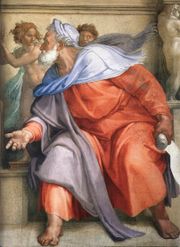
“The work has proved a veritable beacon to our art, of inestimable benefit to all painters, restoring light to a world that for centuries had been plunged into darkness. Indeed, painters no longer need to seek for new inventions, novel attitudes, clothed figures, fresh ways of expression, different arrangements, or sublime subjects, for this work contains every perfection possible under those headings.”
Waldemar Januszczak
The art critic and television producer Waldemar Januszczak wrote that when the Sistine Chapel ceiling was recently cleaned, he "was able to persuade the man at the Vatican who was in charge of Japanese TV access to let me climb the scaffold while the cleaning was in progress.
"I sneaked up there a few times. And under the bright, unforgiving lights of television, I was able to encounter the real Michelangelo. I was so close to him I could see the bristles from his brushes caught in the paint; and the mucky thumbprints he’d left along his margins. The first thing that impressed me was his speed. Michelangelo worked at Schumacher pace. Adam’s famous little penis was captured with a single brushstroke: a flick of the wrist, and the first man had his manhood. I also enjoyed his sense of humour, which, from close up, turned out to be refreshingly puerile. If you look closely at the angels who attend the scary prophetess on the Sistine ceiling known as the Cumaean Sibyl, you will see that one of them has stuck his thumb between his fingers in that mysteriously obscene gesture that visiting fans are still treated to today at Italian football matches."
Gabriel Bartz and Eberhard König
"In a world where all experience was based in the glorious lost past of Antiquity, he made a new beginning. Michelangelo, more even than Raphael or Leonardo, embodies a standard of artistic genius which reveals a radically changed image of human beings and their potential..."
Pope John Paul II

“It seems that Michelangelo, in his own way, allowed himself to be guided by the evocative words of the Book of Genesis which, as regards the creation of the human being, male and female, reveals: "The man and his wife were both naked, yet they felt no shame". The Sistine Chapel is precisely - if one may say so - the sanctuary of the theology of the human body. In witnessing to the beauty of man created by God as male and female, it also expresses in a certain way, the hope of a world transfigured, the world inaugurated by the Risen Christ……”
Michelangelo
"Whatever beauty here on earth is seen,
To meet the longing and perceptive eye,
Is semblance of that source divine,
From whence we all are come.
In this alone we catch a glimpse of Heaven."

